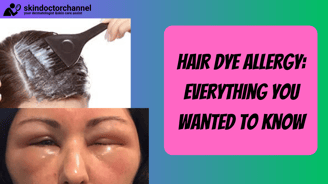Hair Dye Allergy and Safer Alternatives
Discover the truth about hair dye allergies in our comprehensive guide. We uncover the risks associated with common hair dye chemicals like PPD and ammonia, explore safer alternatives, and celebrate the empowering choice of embracing your natural beauty. Explore your hair color options while making informed decisions about your well-being and self-expression.
DR.Sujith Karimbil
10/8/20232 min read


Hair Dye Allergy: Unraveling the Risks and Alternatives
Introduction
Hair dyeing has been a popular form of self-expression for centuries, allowing individuals to experiment with different looks and styles. However, amidst the allure of vibrant hues and transformative hair colors, there exists a crucial concern: hair dye allergies. In this comprehensive guide, we'll explore the risks associated with hair dye allergies, the chemicals responsible, safer alternatives, and the empowering choice of embracing your natural beauty
Understanding Hair Dyes
Hair dyes are cosmetic products designed to alter the color of your hair. They come in various forms, catering to different preferences and needs. Whether you're going for a bold new look or simply want to cover those greys, there's a hair dye for you.
Understanding Hair Dye Allergy:( The Risk of Allergic Reactions: While hair dyes offer fantastic results, they can also be risky when it comes to allergic reactions. Hair dye allergies occur when the body's immune system reacts to certain chemicals present in hair dyes. These reactions typically occur due to the chemicals found in hair dyes, primarily paraphenylenediamine (PPD) and ammonia.
The Role of PPD and Ammonia. One of the primary culprits is paraphenylenediamine (PPD), a common ingredient used in many hair dyes that has been known to cause allergic reactions in some individuals Allergic reactions can range from mild itching and redness to more severe symptoms such as swelling and blistering. Ammonia, used in permanent hair dyes, helps the color penetrate the hair shaft by opening the cuticle. However, it can also irritate the scalp and skin.
PPD-Free Hair Colors
If you're concerned about PPD or ammonia, there's good news. PPD-free hair colors and ammonia-free options are widely available. These alternatives aim to minimize the risk of allergic reactions and scalp irritation
PPD and Health Concerns
It's important to acknowledge that prolonged exposure to PPD has raised health concerns, including the potential risk of bladder cancer. While scientific debates continue, it's essential to be aware of these potential risks.
Embracing Natural Beauty
In the quest for youthful looks and ever-changing trends, it's easy to forget the beauty of ageing gracefully. Embracing your natural hair color can be a liberating choice. It's safer, healthier, and allows you to shine with your unique beauty.
The Patch Test
To safeguard against hair dye allergies, always perform a patch test. Apply a small amount of the dye to a discreet area of skin and wait for 48 hours. If you experience any signs of an allergic reaction during this time, avoid using that particular hair dye. A professional patch test is done by a dermatologist by using an allergy panel, and it is advisable to get one done.
Conclusion
Hair dyes are fantastic tools for personal expression and transformation. However, they also come with risks, especially concerning allergies and potential health concerns associated with ingredients like PPD. Exploring PPD-free and ammonia-free options is a prudent choice if you're concerned about allergies. And remember, embracing your natural hair colour is a beautiful journey in itself, promoting not only personal confidence but also health and well-being.
So, whether you choose to go bold with hair dye or gracefully embrace your natural grey, the key is to make informed choices that align with your unique style and priorities.
